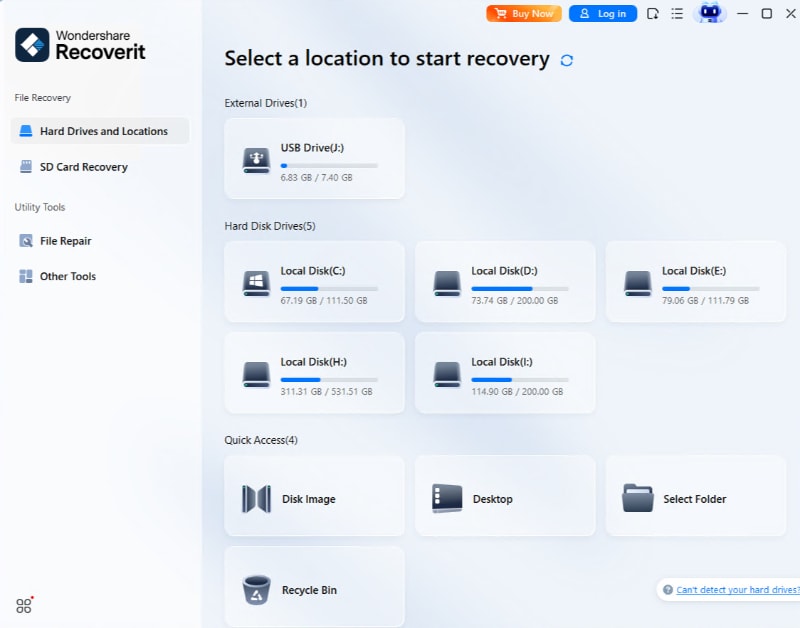Understanding RAID 1 recovery is essential for users who rely on this mirrored storage setup. Since RAID 1 duplicates your data across two hard drives, a single drive failure usually doesn't result in data loss—your files remain safe on the functioning drive. Still, unexpected issues can arise.
Sometimes, both drives can break, the RAID controller might stop working, or the software can get messed up. When these things happen, it's really important to know how to recover your data using RAID 1 methods.
We'll look at different ways to get back files from a RAID 1 drive. We'll also talk about how to rebuild RAID 1 setups and how to avoid losing data in the future. Whether you use a simple home setup or a QNAP RAID 1 recovery situation, this guide has you covered.
Try Recoverit to Retrieve Lost Data
Security Verified. Over 7,302,189 people have downloaded it.
In this article
What is RAID 1 and Its Data Mirroring Function

RAID 1 is a storage configuration known for its reliability. It creates exact copies of your data—a process called mirroring—across two or more drives. Every time a file is saved, it’s written to all drives simultaneously.
If one drive fails, the mirrored copy ensures your data remains safe and accessible, letting you continue working without interruption. This built-in redundancy makes RAID 1 a popular choice for storing critical information, especially in environments where data loss is not an option.
The system gives you protection against single-drive failures. However, RAID 1 recovery becomes necessary when multiple problems happen at once.
The mirroring function works automatically in the background. You do not see the copying process happening. The RAID controller manages everything. It makes sure both drives have the same data. When you read a file, the controller can get it from either drive. This can actually make reading faster. But writing is slower because data goes to multiple drives. RAID 1 data recovery is needed when this mirroring system breaks down.
Common Causes of RAID 1 Data Loss
RAID 1 systems can fail for many reasons:
- Drive failures: Both drives can fail at the same time or close together. Age, manufacturing defects, or power surges often cause this. When both drives fail, you need professional RAID 1 data recovery services.
- Controller problems: The RAID controller manages the mirroring process. If it fails or gets corrupted, you cannot access your data properly. This makes rebuilding RAID 1 arrays necessary.
- Software corruption: Operating system problems or driver issues can corrupt the RAID configuration. This makes the system think the array is broken when the drives are actually fine.
- Power issues: Sudden power loss or electrical surges can damage both drives simultaneously. This bypasses the protection that RAID 1 normally provides.
- Human errors: Accidentally deleting files, formatting drives, or breaking the array affects all mirrored copies. Users sometimes make mistakes that hurt all drives at once.
- Malware attacks: Viruses and ransomware can encrypt or delete files on all drives in the array. The mirroring copies the damage to every drive.
- Firmware bugs: Problems with drive firmware or RAID controller firmware can cause data corruption or make drives unreadable.
- Physical damage: Fire, flood, theft, or other disasters can destroy multiple drives at once. Environmental factors affect all drives in the same location.
How to Perform RAID 1 Recovery
Method 1: Use the Recoverit Tool
Recoverit is a popular data recovery software that works well for RAID 1 recovery situations. The tool can scan individual drives from broken RAID arrays. The intuitive interface makes it ideal for everyday users, even without technical expertise. It supports a wide range of file types and storage systems, including RAID configurations.
The software uses advanced scanning technology to find lost data. It can recover files even when the file system is damaged. Recoverit also works with different types of drives including SATA, SSD, and external drives. The tool shows you a preview of recoverable files before you restore them. This helps you pick the files you really need.
Why choose this method:
- Easy-to-use interface suitable for beginners
- Works with individual drives from broken RAID arrays
- Supports many file types and formats
- Shows a preview of recoverable files before restoration
Recovery Steps:
Step 1: Install Recoverit on your PC. Connect the RAID 1 member drives to this computer. Launch Recoverit. Select the RAID 1 drive you want to scan.

Step 2. Recoverit will scan the entire drive for recoverable files.

Step 3: After scanning your RAID 1 array, carefully review the results and choose the files you wish to recover. To avoid overwriting or further corruption, make sure to save the recovered files to a separate drive—never back to the original RAID 1 members.

Video Tutorial: What is RAID 1?
Method 2: Reconstruct RAID 1 Array
Virtual RAID reconstruction creates a software copy of your broken RAID array. This method works when the drives are physically okay, but the RAID information is lost. Virtual tools read the drives and figure out how they were arranged. They create a virtual array that you can access like a normal drive.
This approach is good for RAID 1 data recovery when the controller fails or the configuration gets corrupted. You can often recover all your data without losing the folder structure and file names.
Why choose this method:
- Preserves original folder structure and file organization
- Works when the RAID controller or configuration is damaged
- Can handle complex RAID problems that other tools cannot
- Often recovers more complete data than file-level recovery
Recovery Steps:
Step 1: Get professional RAID recovery software like R-Studio. Connect all RAID 1 member drives to a working computer. Use the virtual RAID reconstruction feature. Tell the software you have a RAID 1 array. Let it scan the drives and detect the original configuration automatically.

Step 2: Once the virtual array is created, browse it like a normal drive. Copy all important data to a safe location before trying to rebuild the physical array.
Method 3: Recover Data from a Healthy RAID 1 Member Drive
This method works when one drive in your RAID 1 array is still working properly. Since RAID 1 creates exact copies, a healthy drive contains all your data. You can connect this drive to another computer and access your files directly.
This is often the fastest way to recover data from RAID 1 drive systems. The healthy drive acts like a normal single drive. You can copy files, browse folders, and use the data normally. This method works best when you know which drive is good and which one failed.
Why choose this method:
- Fastest recovery when one drive is completely healthy
- No special software needed for basic file access
- Preserves all file attributes and permissions
- Works even when the RAID controller is completely broken
Recovery Steps:
Step 1: Turn off the RAID system and carefully remove both drives. Connect each drive individually to a working computer using SATA cables. Check which drive is readable and contains your data. The healthy drive should show up as a normal drive with your files and folders visible.

Step 2: Copy all important data from the healthy drive to a backup location. Verify that all files are copied correctly before using them.
Method 4: Restore Data from Backup (If Available)
Backup restoration is the safest and most reliable RAID 1 recovery method. If you have recent backups of your data, you can restore everything quickly. This method works regardless of what happened to your RAID 1 array. Complete drive failures, controller problems, and data corruption cannot affect properly stored backups.
The restore process gives you clean, uncorrupted files. You also get back the exact folder structure and file organization you had before. This makes backup restoration the preferred method when backups exist.
Why choose this method:
- Most reliable recovery method with guaranteed clean data
- Works regardless of RAID array condition or damage type
- Maintains complete file structure and organization
- Usually faster than other recovery methods
Recovery Steps:
Step 1: Locate your most recent backup files or connect to your backup system. Verify that the backup contains the data you need to restore. Prepare a new storage system to receive the restored data. This could be new RAID 1 drives, a single large drive, or cloud storage.

Step 2: Run the restore process from your backup software. Verify that all important files were restored correctly before deleting the old RAID array.
Method 5: Seek Help from Professional RAID Recovery Services
Professional RAID recovery services have specialized tools and expertise for complex problems. They can handle situations where other methods fail. Professional services work in clean rooms to prevent further damage. They have hardware tools that regular users cannot buy. These tools can read data from severely damaged drives.
Professional services also have experience with many different RAID controllers and configurations. This includes specialized systems like QNAP RAID 1 recovery situations that need specific knowledge.
Tips to Prevent RAID 1 Data Loss
📊 Check drive health often. Use SMART tools monthly to spot issues early. Swap out troubled drives before they die.
💾 Backups are a must. RAID doesn't replace backups. Keep extra copies in safe places and test them regularly.
⚡ Protect from power issues. Use a UPS to prevent power cuts. Surge protectors help avoid damage from spikes.
🧰 Stay updated. Keep your RAID controller and system drivers current to avoid bugs and corruption.
🌡️ Manage the environment. Keep drives cool and dry. Block dust, shaking, and extreme temperatures to extend drive life.
👨🏫 Teach users. Make sure people know how to use the system properly to avoid accidental mistakes.
🔁 Replace drives on time. Don’t wait for failure—replace aging drives early and keep spares ready.
📘 Keep a record. Write down your RAID setup details. It’ll help big time if you ever need to rebuild.
Conclusion
RAID 1 recovery requires understanding both the technology and available recovery methods. This guide covered five main approaches to recovering data from RAID 1 drive systems. Each method works best in different situations. Software tools like Recoverit work well for basic recovery needs.
The key to successful RAID 1 data recovery is choosing the right method for your situation. Start with the simplest approach that fits your problem. Move to more complex methods only if needed. Always work with copies of your drives when possible to avoid making problems worse. Remember that RAID 1 recovery is just one part of a complete data protection strategy.
FAQs
-
Can I recover data if both RAID 1 drives fail?
Yes, you can often recover data even when both RAID 1 drives fail. The success depends on the type of failure and how much damage occurred. Logical failures like corruption or accidental formatting often allow full recovery using specialized software. Physical failures require professional RAID recovery services with cleanroom facilities. Even severely damaged drives sometimes yield recoverable data. -
How long does RAID 1 recovery usually take?
RAID 1 recovery time varies greatly depending on the method used and the amount of data involved. Simple software recovery from healthy drives takes a few hours to copy files. Virtual RAID reconstruction can take 12-24 hours for scanning and rebuilding large arrays. Professional RAID recovery services typically need 3-7 business days for standard cases. Emergency services cost more but can complete QNAP RAID 1 recovery and other complex cases in 24-48 hours. -
Is it safe to attempt RAID 1 recovery myself?
DIY RAID 1 recovery is safe when done carefully with the right knowledge and tools. Always work with copies of your drives when possible to avoid making problems worse. Simple methods like recovering from healthy member drives carry minimal risk. Software-based recovery is generally safe if you follow instructions carefully.


 ChatGPT
ChatGPT
 Perplexity
Perplexity
 Google AI Mode
Google AI Mode
 Grok
Grok























